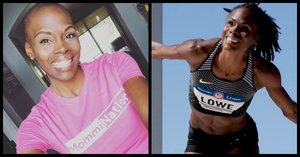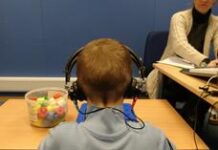Chaunté Lowe is a phenomenal athlete who has competed in the Olympics four different times: Athens in 2004, Beijing in 2008, London in 2012, and Rio in 2016. She holds the American record for indoor and outdoor high jump.She is also a recent breast cancer survivor.“I am training, and I have trained through chemotherapy, a double mastectomy, and treatment for breast cancer,” Lowe told Susan G. Komen. “I know that through it, I can bring a lot of attention to this cause and I know that it will help us eradicate this disease that has ravaged so many of us.” Photo: YouTube/Susan G. KomenWhen Lowe was 34, she found a lump about the size of a grain of rice in her breast. She underwent a check-up with her doctor, but he told her it was nothing and that he “definitively” didn’t want to see her for six more years, until she reached the age of 40.
Photo: YouTube/Susan G. KomenWhen Lowe was 34, she found a lump about the size of a grain of rice in her breast. She underwent a check-up with her doctor, but he told her it was nothing and that he “definitively” didn’t want to see her for six more years, until she reached the age of 40.
Lowe monitored the lump, and as it grew, so did her anxiety. She’s an exceptional athlete, and she knows her body well. Something was not right. Photo: Instagram/Chaunte LoweNearly a year after her visit with the doctor, she went to another one for a second opinion. She had a biopsy right away, and in June of 2019, she was diagnosed with triple negative breast cancer.
Photo: Instagram/Chaunte LoweNearly a year after her visit with the doctor, she went to another one for a second opinion. She had a biopsy right away, and in June of 2019, she was diagnosed with triple negative breast cancer.
Triple negative breast cancer (TNBC) is an aggressive form of the disease that accounts for 10-20% of breast cancer cases and disproportionately affects younger people, African Americans, Hispanics, and people with a BRCA1 gene mutation. Photo: YouTube/Susan G. KomenBlack women in the United States are often diagnosed with more aggressive forms of breast cancer than white women, and are 40% more likely to die from breast cancer than white women. This is due in part to being diagnosed late. Her doctor’s misdiagnosis put Lowe on a delayed track for treatment, but she’s doing great despite the error and is determined to raise awareness.
Photo: YouTube/Susan G. KomenBlack women in the United States are often diagnosed with more aggressive forms of breast cancer than white women, and are 40% more likely to die from breast cancer than white women. This is due in part to being diagnosed late. Her doctor’s misdiagnosis put Lowe on a delayed track for treatment, but she’s doing great despite the error and is determined to raise awareness.
“I wish that somebody would’ve told me about my risk,” she said. “At [the time of my diagnosis], I felt like it was my personal responsibility to share everything that I had learned about battle, fighting, perseverance, overcoming obstacles, endurance, that it was my responsibility to teach other women this.” Photo: Instagram/Chaunte LoweLowe underwent a double mastectomy and chemotherapy — and kept up her Olympic training through it all. She had her sights set on competing in the 2020 Olympic Games. When the coronavirus started sweeping through the world, Lowe was worried about how her weakened immune system would withstand possibly being exposed to the virus during the trip. But she was still determined to go.
Photo: Instagram/Chaunte LoweLowe underwent a double mastectomy and chemotherapy — and kept up her Olympic training through it all. She had her sights set on competing in the 2020 Olympic Games. When the coronavirus started sweeping through the world, Lowe was worried about how her weakened immune system would withstand possibly being exposed to the virus during the trip. But she was still determined to go.
Now the 2020 games have been delayed until 2021 because of the COVID-19 pandemic. Though Lowe says the postponement of the Olympics to 2021 was a smart choice, it has had an exhausting impact on the athletes expecting to compete. Photo: YouTube/Susan G. Komen“You put your life on hold for the Olympics. Imagine if you’ve ever been on a tough diet, and you’re like, ‘OK, I could hold it for this long, but at this point in time, I’m going to break,’” she told CNN. “And now they’re telling you everything that you’ve done to put your life on hold, you have to do it a whole other year — it’s going to be very difficult.”Athletes are at their peak readiness right now, and they basically have to stay in a holding pattern mentally and physically for another year.
Photo: YouTube/Susan G. Komen“You put your life on hold for the Olympics. Imagine if you’ve ever been on a tough diet, and you’re like, ‘OK, I could hold it for this long, but at this point in time, I’m going to break,’” she told CNN. “And now they’re telling you everything that you’ve done to put your life on hold, you have to do it a whole other year — it’s going to be very difficult.”Athletes are at their peak readiness right now, and they basically have to stay in a holding pattern mentally and physically for another year.
 Photo: YouTube/Susan G. KomenHer experience was breast cancer has made Lowe passionate about advocating for women and raising awareness for this awful disease.“You know your body better than any doctor. Don’t let them tell you that it is nothing,” she wrote on Instagram. “Keep pressing until you are satisfied. I did self breast exams at least weekly in the shower and know the exact day the lump showed up, and still it took 9-10 months for medical personnel to take me seriously because of my age. I don’t drink, I don’t smoke, I exercise regularly and none of that made a difference. Cancer doesn’t care. Get checked!”Thankfully, Lowe’s treatment was successful and she has no evidence of cancer cells remaining.Proper BCS greatergood_ctg_abovevideoSource
Photo: YouTube/Susan G. KomenHer experience was breast cancer has made Lowe passionate about advocating for women and raising awareness for this awful disease.“You know your body better than any doctor. Don’t let them tell you that it is nothing,” she wrote on Instagram. “Keep pressing until you are satisfied. I did self breast exams at least weekly in the shower and know the exact day the lump showed up, and still it took 9-10 months for medical personnel to take me seriously because of my age. I don’t drink, I don’t smoke, I exercise regularly and none of that made a difference. Cancer doesn’t care. Get checked!”Thankfully, Lowe’s treatment was successful and she has no evidence of cancer cells remaining.Proper BCS greatergood_ctg_abovevideoSource






